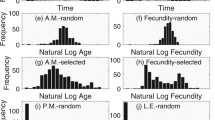Abstract
Competition between several cladoceran species has been studied with the use of simulation. The results have demonstrated that, in most cases, one or two species survive. Under conditions of the minimum food supply, the most competitive species have the selective advantage. With an increase in food supply, the survival of low-competitive species was observed more often. The mean body size of surviving species increases with an increase in food reproduction.
Similar content being viewed by others
References
Allan, J.D., Life History Patterns in Zooplankton, Am. Nat., 1976, vol. 110, no. 971, pp. 165–180.
Boer den, P.J., Exclusion or Coexistence and the Taxonomic or Ecological Relationship between Species, Neth. J. Zool., 1980, vol. 30, no. 2, pp. 278–306.
Brooks, J.L. and Dodson, S.L., Predation, Body Size, and Composition of Plankton, Science, 1965, vol. 150, no. 3692, pp. 28–35.
Deihl, S. and Feissel, M., Effects of Enrichment on Three-Level Food Chains with Omnivory, Am. Natur., 2000, vol. 155, pp. 200–218.
Frank, P.W., A Laboratory Study of Intraspecies Competition in Daphnia pulicaria (Forbes) and Simacephalus vetulus O.F. Muller, Physiol. Zool., 1952, vol. 25, pp. 178–204.
Frank, P.W., Coaction in Laboratory Populations of the Two Species of Daphnia, Ecology, 1957, vol. 38, pp. 510–518.
Gause, G.F., The Struggle for Existence, Baltimore: Williams and Wilkins, 1934.
Gilyarov, A.M., Dinamika chislennosti presnovodnykh planktonnykh rakoobraznykh (Population Dynamics of Freshwater Planktonic Crustaceans), Moscow: Nauka, 1987.
Gliwicz, Z.M., Between Hazards of Starvation and Risk of Predation: The Ecology of Offshore Animals. International Ecology Institute (Germany), Excellence in Ecology, 2003, vol. 12.
Goulden, C.E. and Hornig, L.L., Population Oscillations and Energy Reserves in Planktonic Cladocera and Their Consequences to Competition, Proc. Natl. Acad. Sci. USA, 1980, vol. 77, no. 3, pp. 1716–1720.
Goulden, C.E., Henry, L.L., and Teissier, A.J., Body Size, Energy Reserves and Competitiveness in Three Species of Cladocera, Ecology, 1982, vol. 63, no. 6, pp. 1780–1790.
Hu, S.S. and Tesser, A.J., Seasonal Succession and the Strength of Intra-and Interspecific Competition in a Daphnia Assemblage, Ecology, 1995, vol. 76, pp. 2278–2294.
Hutchinson, G.E., The Paradox of the Plankton, Am. Nat., 1961, vol. 95, no. 882, pp. 137–145.
Kreutzer, C. and Lampert, W., Exploitative Competition in Differently Sized Daphnia Species: A Mechanistic Explanation, Ecology, 1999, vol. 80, pp. 2348–2357.
Laxston, C.L., Mcphedran, K.N., Makarewicz, J.C., and Telesh, I.V., Effects of the Non-Indigenous Cladoceran Cercopagis pengoi on the Lower Food Web of Lake Ontario, Freshwater Biol., 2003, vol. 48, pp. 2094–2106.
Lynch, M., Complex Interactions Between Natural Coexploiters—Daphnia and Ceriodaphnia, Ecology, 1978, vol. 59, pp. 552–564.
MacIsaac, H.J., Grigorovich, I.A., Hoyle, J.A., et al., Invasion of Lake Ontario by the Ponto-Caspian Predatory Cladoceran Cercopagis pengoi, Can. J. Fish. Aquat. Science, 1999, vol. 56, pp. 1–5.
Makarewicz, J.C., Grigorovich, I.A., Mills, E.L., et al., Distribution, Fecundity and Genetics of Cercopagis pengoi (Ostroumov) (Crustacea, Cladocera) in Lake Ontario, J. Great Lakes Res., 2001, vol. 27, pp. 19–32.
McCann, K., Density-Dependent Coexistence in Fish Communities, Ecology, 1998, vol. 79, pp. 2957–2967.
Montague, C.L., Fey, W.L., and Gillespie, D.M., A Causal Hypothesis Explaining Predator-Prey Dynamics in Great Salt Lake, Utah, Ecol. Model., 1982, vol. 17, pp. 271–295.
Neill, W.E., Experimental Studies Microcrustacean Competition, Community Composition, and Efficiency of Resource Utilization, Ecology, 1975, vol. 56, pp. 809–826.
Neill, W.E., Experimental Studies on Factors Limiting Colonization by Daphnia pulex Leydig of Coastal Mountain Lakes in British Columbia, Can. J. Zool., 1978, vol. 56, pp. 2498–2507.
Pianka, E.R., Evolutionary Ecology, New York: Harper and Row, 1978. Translated under the title Evolyutsionnaya ekologiya, Moscow: Mir, 1981.
Ranta, E., Niche of Daphnia Species in Rock Pools, Arch. Hydrobiol., 1979, vol. 87, pp. 205–223.
Riley, G.A., Marine Biology I, Proc. First International Interdisciplinary Conference, American Institute of Biological Science, 1963, pp. 69–70.
Romanovsky, Yu.E., Individual Growth Rate as a Measure of Competitive Advantage in Cladoceran Crustaceans, Intern. Rev. Gesamt. Hydrobiol., 1984, vol. 69, no. 5, pp. 613–632.
Romanovsky, Yu.E., Food Limitation and Life-History Strategies in Cladoceran Crustaceans, Arch. Hydrobiol. Beih. Ergebn. Limnol., 1985, vol. 21, pp. 363–372.
Romanovsky, Yu.E. and Feniova, I.Yu., Competition among Cladocera: Effect of Different Levels of Food Supply, Oikos, 1985, vol. 44, no. 2, pp. 243–252.
Semenchenko, V.P., Comparative Analysis of Reproductive Strategies in Cladoceran Crustaceans (Cladocera) at Different Food Concentrations, Zh. Obshch. Biol., 1990, vol. 51, no. 6, pp. 828–835.
Shea, K. and Chesson, P., Community Ecology Theory as a Framework for Biological Invasions, Trends Ecol. Evol., 2002, vol. 17, pp. 170–176.
Smith, D.W. and Cooper, S.D., Competition Among Cladocera, Ecology, 1982, vol. 53, pp. 375–386.
Sprules, W.G., Effects of Size-Selective Predation and Food Competition on High Altitude Zooplankton Communities, Ecology, 1972, vol. 53, no. 3, pp. 375–386.
Sushchenya, L.M., Kolichestvennye zakonomernosti pitaniya rakoobraznykh (Quantitative Trends in the Feeding of Crustaceans), Minsk: Nauka i Tekhnika, 1975.
Tilman, D., Tests of Resource Competition Theory Using Four Species of Lake Michigan Algae, Ecology, 1981, vol. 62, pp. 802–815.
Wichmann, B.A. and Hill, I.D., An Efficient and Portable Pseudo-Random Number Generator, Applied Statistics, 1982, vol. 38, pp. 188–192.
Author information
Authors and Affiliations
Additional information
Original Russian Text © I.Yu. Feniova, S.V. Budaev, Yu.Yu. Dgebuadze, 2006, published in Ekologiya, 2006, Vol. 37, No. 1, pp. 32–38.
Rights and permissions
About this article
Cite this article
Feniova, I.Y., Budaev, S.V. & Dgebuadze, Y.Y. Simulation of cladoceran survival strategy under conditions of food depletion. Russ J Ecol 37, 28–34 (2006). https://doi.org/10.1134/S106741360601005X
Received:
Issue Date:
DOI: https://doi.org/10.1134/S106741360601005X




